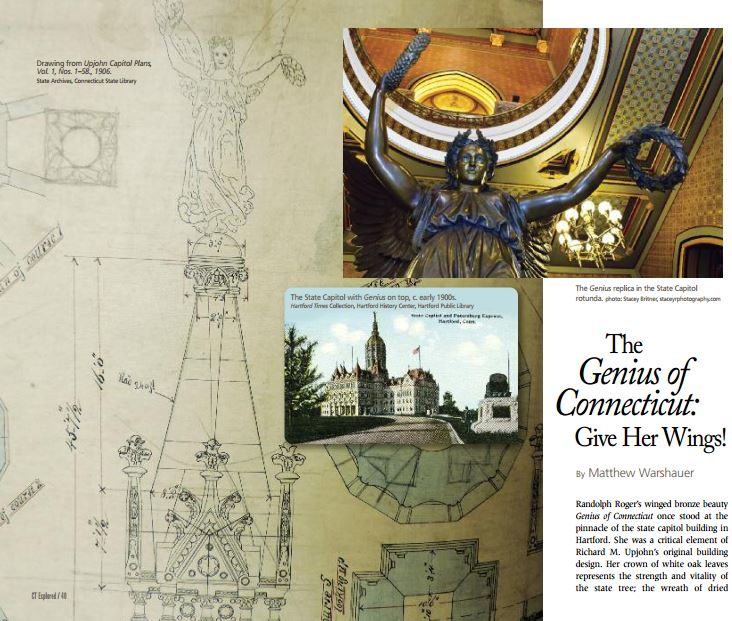By Matthew Warshauer
(c) Connecticut Explored Inc. SUMMER 2015
Subscribe/Buy the Issue!
Randolph Roger’s winged bronze beauty Genius of Connecticut once stood at the pinnacle of the state’s capitol building in Hartford. She was a critical element of Richard M. Upjohn’s original building design. Her crown of white oak leaves represents the strength and vitality of the state tree; the wreath of dried flowers in her right hand embodies long life, and the wreath in her left hand is mountain laurel, the state flower. Her outstretched wings allowed her to fly high—nearly 260 feet above the ground—as the shield and protector for the state’s people. Her name, Genius, reflects the intention that she embodied the state’s spirit of innovation.
Placed atop the capitol’s dome when that building was completed in 1878, Genius held special meaning to the generation that created the new center of state government. After the bloody, horrifying, nation-altering Civil War, the capitol was to serve as a shrine to the shared sacrifice that preserved the Union and brought freedom to all of the nation’s citizens.
Genius embodied a philosophy about Connecticut’s spirit of innovation and ability. Such qualities had long existed, from the founding of the colony and its pioneering experiments in self-government to the crucial role we played in the American Revolution and the spirit of progress and technological know-how that placed Connecticut at the forefront of invention and manufacturing beginning in the 19th century and continuing today.
For 60 years, until the 1938 hurricane roared up the east coast and made necessary her removal, Genius soared over the state’s capitol. During World War II, she was melted down for her precious metals to aid the Allied war effort. In 2009, a replica was cast with the intention that Genius would once again crown the capitol’s dome, restoring the capitol to its original splendor.
But returning Genius to the top of the capitol dome requires engineering know-how, strong community spirit, and appreciation for what the statue represents and how it can inspire future generations. It also, of course, requires money.
How You Can Help
In the coming months, keep an eye out for The Genius Campaign, which will be a broad-based community effort aimed at expressing pride in our state’s legacy of innovation and recommitting ourselves to Connecticut as a place that fosters learning, innovation, and creativity. The Genius is a symbol of these important ideals and the campaign will focus on raising the $400,000 needed to return Genius to where she belongs. If you would like to be involved in The Genius Campaign, contact Dr. Matthew Warshauer at warshauerm@ccsu.edu.
Let’s come together to place Genius where she belongs—on top!
Matthew Warshauer is professor of history at Central Connecticut State University, co-chair of the Connecticut Civil War Commemoration Commission, and a member of Connecticut Explored’s editorial board. Anthony Roy is a social studies teacher at the Connecticut River Academy in Hartford.
Explore!
“The Genius of Connecticut,” Winter 2006/2007
The State Capitol
201 Capitol Avenue, Hartford
cga.ct.gov/capitoltours/, 860-240-0222
Construction on the Connecticut State Capitol began in 1872, the year Hartford was selected as the sole capitol (previously the legislature met alternate years in New Haven and Hartford). The capitol incorporates the most memorial elements to the Civil War—19—of any capitol building in the U.S., according to Matt Warshauer’s research. As part of its commemoration of the 150th anniversary of the war, the Civil War Commemoration Commission added one memorial, the Forlorn Soldier, and ensured that the battle flags of the 29th and 30th (Colored) Connecticut Volunteer Infantry are on public display (Civil War battle flags from other regiments may also be seen in the Hall of Flags). The High Victorian Gothic style statehouse was designated a Registered National Historic Landmark in 1971 and underwent a restoration between 1979 and 1989. Currently, the stained glass laylights under the domed skylights are approximately half-way through a $700,000 restoration. When you visit, see how many of the 19 Civil War memorials (inside and on the grounds) you can spot.
Free tours of the capitol are available hourly, Monday through Friday, 9:15 a.m. – 1:15 p.m. excluding state holidays. Call to confirm tour times on the day you plan to visit.
“Recollections: The Genius of Connecticut,” Winter 2006/2007
Read all of our stories about Connecticut’s art history on our TOPICS page

